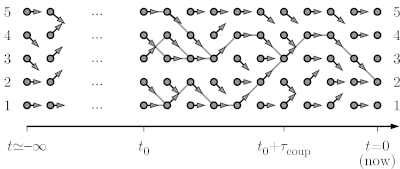Diffusion CFTP.py
From Werner KRAUTH
Context
This page is part of my 2024 Beg Rohu Lectures on "The second Markov chain revolution" at the Summer School "Concepts and Methods of Statistical Physics" (3 - 15 June 2024).
In the example of a particle diffusing on a path graph with five sites, with moves from configuration i to [i-1, i, i] being proposed, we consider the formulation of a Markov chain in terms of random maps, but run from time t=-infinity up to time t=0.
Python program
import random
import matplotlib.pyplot as plt
N = 5
pos = []
for stat in range(100000):
all_arrows = {}
time_tot = 0
while True:
time_tot -= 1
arrows = [random.choice([-1, 0, 1]) for i in range(N)]
if arrows[0] == -1: arrows[0] = 0
if arrows[N - 1] == 1: arrows[N - 1] = 0
all_arrows[time_tot] = arrows
positions=set(range(0, N))
for t in range(time_tot, 0):
positions = set([b + all_arrows[t][b] for b in positions])
if len(positions) == 1: break
a = positions.pop()
pos.append(a)
plt.title('Backward coupling: 1-d with walls: position at t=0')
plt.hist(pos, bins=N, range=(-0.5, N - 0.5), density=True)
plt.savefig('backward_position_t0.png')
plt.show()

